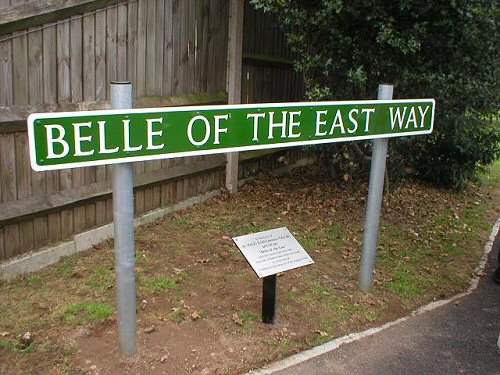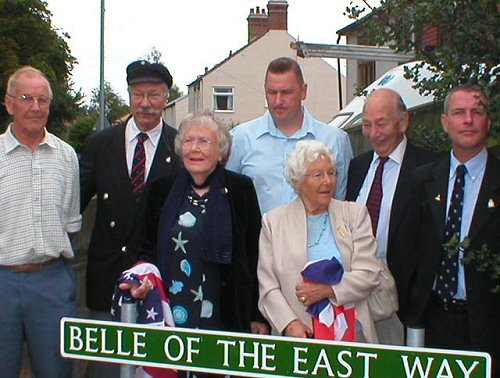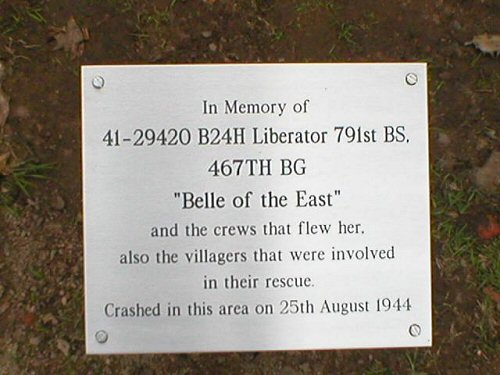Miscellaneous Items of the 467th BG(H)
"Belle of the East" Road Naming Ceremony
On the 26th Aug. 2006 exactly 62 years after the event, villagers in Belton, Norfolk, gathered for a ceremony to unveil a road sign called "Belle Of The East Way" in memory of the Group B24 that crash-landed here during WW2.
This road sign is in addition to a commemorative plaque that hangs on the local Tavern Pub.
Thanks to Richard Lindsey, a local man who has meticulously researched the event and history of both the crew and aircraft, he was instrumental in getting the local council to name the road through his efforts with the Belton Historical Society.
The EDP local newspaper reported the story as follows:
As a young nurse on leave at her parents' farmhouse, Hazel Guyton had no hesitation about springing into action the moment the war literally crashed in on their peaceful Norfolk village.
First she saw American airmen parachuting down and then their plane, still with three on board, "hedge-hopped over our house and crashed into our Victoria plum orchard at the back, making a proper mess of it".
She still vividly recalls her father warning her there might yet be a bomb on board, but the instinct of a nurse who had treated casualties from Dunkerque took over and she dashed out to pull them from the wreckage of the Liberator bomber, Belle of the East.
Sixty-two years on, almost to the day, Hazel, 89, and now Mrs Davies, travelled from her home in Hampshire to the exact same spot in Belton, near Yarmouth, to officially name a new road, Belle of the East Way.
And assisting her in unveiling a special plaque beneath the road sign was Primrose Williams, 76, from Coltishall, a wartime friend of David Grinnell, the last surviving airman from the stricken aircraft.
Left to Right: Ken Lindsay, Sqn. Ldr. Geoff Williams, Primrose Williams, Richard Lindsey (Reseacher/Historian), Mrs Hazel Guyton, Dick Barker (Belton Parish councillor) and Ian Walker (Project Manager).
The EDP artcle continues.......
Mr Grinnell, nearly blind and not well enough to travel from his home in Washington DC, sent a message, read out by Mrs Williams, saying he was disappointed to have been unable to make his third visit to Belton, "the first being on August 25, 1944 and unexpected".
He went on: "We were on our approach to Rackheath air base from a mission in Germany when something went very wrong.
"We lost altitude rapidly and the next thing I remember was scrambling out of a large hole in what was left of the Belle of the East.
"I was dazed but did not have even a scratch. It was comforting to sit on terra firma and assure the kind and concerned folks of Belton that I was fine, thank you."
Mr Grinnell said the village was doing something very special with the road naming, "putting the Belle of the East into the very fabric of your community".
Richard Lindsay, of the Belton and District Historical Society, painstakingly unravelled the story through 12 years of research and the taking of eyewitness statements.
He discovered the bomber had been on its way back from a daylight raid on an aviation factory in Lubeck, Germany, when it suffered engine failure as it was circling to land at Rackheath.
Four of the crew parachuted to safety while the other three "rode her down". Luckily no one was seriously injured.
A commemorative plaque has already been placed in front of the Belton Tavern but an emotional Mr Lindsay said the road naming was "the icing on the cake".
Parish councillor Dick Barker said: "The borough council wrote us a letter three years ago saying we could name a road, and the historical society came up with this idea."
Among the gathering at the unveiling was Derek Houghton, 69, who recalls the drama as a young boy growing up in the village.
He said: "I saw the parachutes and I told my father George, the village policeman who rushed off to help."


